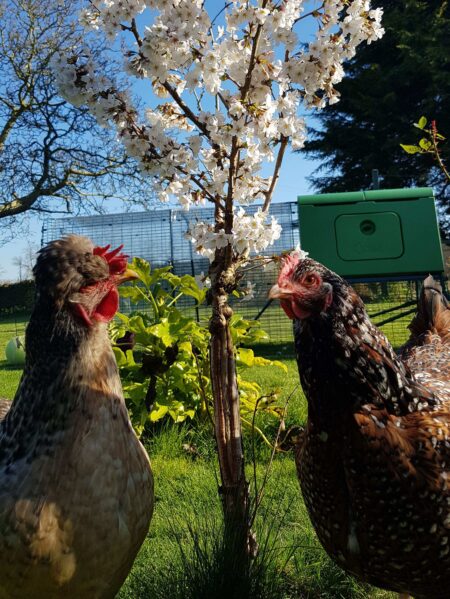What’s Wrong With My Chicken?

If you keep chickens, you already know what a happy, healthy hen looks like. If anything changes, it’s a sign that all is not well in the henhouse.
The commonest problems are not due to diseases or parasites, but stress. If the henhouse is overcrowded, dirty, or too hot, or if the birds are feeling harassed, they will become stressed. The symptoms include egg-eating, aggression to their neighbours, loose droppings, lethargy, and a sudden interruption to their egg-laying.
The cause should be obvious enough, once you stop to look. Too many birds in one house? No shelter from direct sunlight? No room to exercise? Nothing but wet mud? These things can be sorted out by rearranging the hens’ environment, extending the run, and getting a bigger hen coop. Check the hens’ diet, too – are you feeding them a good, fortified chicken feed, supplemented with some corn? Poor nutrition is a gateway to other health issues, as it weakens the birds’ immune systems.
Infectious Bronchitis – The Commonest Chicken Disease
There are many diseases that can afflict chickens, but thankfully most of them are uncommon. Anecdotal evidence shows that Infectious Bronchitis is the one that small-scale backyard hen keepers are most likely to encounter.
Hens suffering from this ailment will have a quiet, rasping, wheezing cough, sneeze or snore. The first signs of the problem are usually a loss of interest in food. As the disease takes hold, the hen will develop a ‘runny nose’, with discharge from the nostrils and eyes.
The bronchitis is caused by an airborne virus, and the best remedy is vaccination of the flock. Any infected birds should be isolated and kept somewhere dry and warm, making sure they eat and drink well. Some will die, but most pull through.
Note: the symptoms described here are also associated with other diseases, including Infectious Sinusitis, Newcastle Disease, and the deadly Aspergillosis, Pullorum and Bird Flu. The Omlet Chicken Guide has more details.
Bumblefoot – The Commonest Chicken Injury
A leg or foot wound that becomes infected can result in Bumblefoot. The wound will not always be obvious, but the biggest clue is a limp, or the tendency to stand for a long time on one leg while the other hens are scratching and pecking for food.
After a few days, the limb will swell, at which point you need to act fast. Taking the bird to a vet is the best bet, as the wound will need thoroughly cleaning, and minor surgery may be involved if the problem is severe. Untreated hens can die.
Not all limps are the result of Bumblefoot, though. Hens sometimes land awkwardly after the chicken version of flying. Broken toes and legs are quite common too, and these will require a splint. But if there is no visible surface wound, Bumblefoot is unlikely to set in.
So, look out for the limp – that’s your first clue that all is not well.
Common Chicken Mites
Chicken parasites are common, but not usually life-threatening. The commonest ones are the mites, of which there are several species.
Red Mite, or Chicken Mite – These nasties hide away in the henhouse, in corners, under perches and elsewhere. Anti-mite powders and liquids can be applied to the coop, and keeping things super-clean at all times will discourage the tiny red bloodsuckers.
Northern Fowl Mite – these are a bit bigger than red mites, and live on the birds rather than just dropping in for a quick bite. Remedies are available, and need to be applied to the bird itself.
Scaly Leg Mite – This variety causes a hen’s legs to become rough, sore and weepy. Antibacterial scaly-leg treatments are the only way to tackle the problem; although rubbing in a little Vaseline can ease the discomfort.
Depluming Mite – This variety burrows into the feather shafts, causing swelling and producing a discharge on which the mites feed. The hens will then begin plucking their own feathers to relieve the discomfort. The mites spread quickly, so the whole flock and henhouse will need treating.
Quick action is the best way of tackling these ailments. Each morning, carry out a quick visual health check. Any of the following should be taken as a warning sign:
- Dirty or messy feathers
- Hunched-up posture
- Lethargy
- Evidence of parasites
- Unhealthy-looking poo
- Sneezing, wheezing, coughing
- No appetite
- No eggs
If you have cause for concern, check out Omlet’s chicken health guide, and call the vet for advice.
This entry was posted in Chickens
